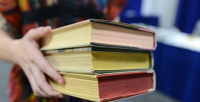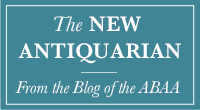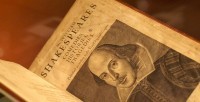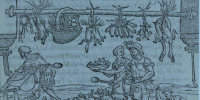A look at some of the items currently offered by ABAA members can present a partial, but nonetheless illuminating, history of various editors' attempts to complete, "improve," or make Shakespeare more accessible over the centuries. For a guy who's been dead for 400 years, Shakespeare gets more press than many movie stars. Every week there's another theory about what he looked like or whether he was high while writing his plays. This week, the headlines are driven by British designer Jamie Rector, who created a series of new conceptual covers for several plays by Shakespeare, attempting to summarize the plays in a series of emojis. Although this was a concept design, the images caught the eye of Creative Review magazine, who are now using them for a series of posters aimed at attracting new design talent -- evidence that Shakespeare's work still remains vital today. London daily paper Metro speculated that if Shakespeare were alive today “chances are he would have been writing his plays in emoji.” I'm not sure if I can agree with that statement -- not least because Shakespeare wrote for the stage, not the smartphone screen -- but adapting Shakespeare for modern audiences is hardly a new idea. Nicholas Rowe got the ball rolling with his critical editions in 1709. While later scholarly editors sought to gloss obscure words and add historical context, Rowe, a poet himself (and evidently not devoid of ego) tried to improve and modernize the text. Alexander Pope took a similar ... [more Editing Shakespeare]
These items are still missing as of 6/11/19. The following items have been reported stolen: "Comitatus Hollandia", Blaeu, 1608 (ref. Schilder VI, 70) "Comitatus Hollandia" Pieter vanden Keere, 1610 (ref. Schilder VI, 71) "Novus XVII Inferioris Germaniae Provinciarum Typus" Blaeu, 1608, 2nd state (ref. Schilder VI, 52) Cornelis van Dalen, Portret van Maurits von Siegen, engraved portrait (Hollstein 137) Lambert Visscher, Portret van Johan de Wit, engraved portrait (Hollstein 31, 2nd state, before the addition of Cornelis de Witt) F.B. van Berkenrode, "Huys te Honsholredyk", engraved view (Hollstein 16) If you have any information on these items please contact Peter Everaers at secundus@zeelandnet.nl. [more Stolen Maps and Engravings]

Belle da Costa Greene Scholarship offers Tuition-plus for Underrepresented Peoples to CABS
By Susan BenneBelle da Costa Greene Scholarship With the goal of actively working to achieve a more diverse and inclusive community of booksellers and librarians, thanks to the generosity of Lisa Unger Baskin, The Colorado Antiquarian Book Seminars (CABS) is pleased to offer a 2017 scholarship for $2,000 to cover the cost of tuition, room and board ($1,646) with the additional $354 intended for travel or incidental expenses. The scholarship is intended for a bookseller or a librarian from an historically underrepresented community. We encourage applications from booksellers and librarians from the African American, Latino/a/x, Asian American/Pacific Islander, LGBTQ+, working class, persons with disabilities, or other self-identified communities of booksellers or librarians who might benefit from this scholarship. Applicants should submit a short 1- or 2-page essay on why they want to attend CABS. They should include in the statement a brief personal and professional history, and something about their relationship to books and the book trade. We also ask for a CV and one letter of support from a member of the book trade, a professional librarian, or another member of the antiquarian book world. This scholarship is named for Belle da Costa Greene, the African-American librarian, bibliographer, and director of the Morgan Library. The deadline to submit your application is May 1, 2017. We will notify the winner by or before May 15, 2017. Submit your application by mail or by email to Garrett S... [more Belle da Costa Greene Scholarship offers Tuition-plus for Underrepresented Peoples to CABS]
Millions of people who have joined, or watched, the recent protests across the country, beginning with the March for Women, have been struck by the diversity of signs in the crowd. Princess Leia as political crusader, puns riffing on the latest social media meme, diagrams of ovaries, statements of solidarity with Muslim refugees – all have been present, in endless variety. Surprisingly, perhaps, it was not always so. Many libraries and museums collect historical protest signs, and the study of these signs reveals many changes over the years — not only in the issues directly addressed by the signs themselves, but in evolving styles of communication, and the influence of the broader cultural environment. It might seem surprising that some libraries, committed to the preservation of literature and the written word, also collect protest signs. If the effort of prose is to persuade, then such signs (as well as pin-back buttons and bumper stickers) are the epitome of concise communication. The simplest signs simply state an opinion, while others make more of an effort to change the reader's mind, to use a turn of phrase to catch attention (and converts). And some signs – often those that reveal the most about their society – make more complex use of text and image, playing the part of a hand-held, sturdier version of a propaganda poster. We could trace the origins of hand-carried political signs to the Roman era if not earlier, but for the purposes of this blog we will exam... [more Protest Signs: Barometers of Social Change]
This item is still missing as of 6/4/2019. The following book has been reported stolen by internet fraud, sold to someone in Los Angeles. (PAINE, Thomas). Common Sense; Addressed to the Inhabitants of America, on the following interesting Subjects. (1776). : Lettre de Thomas Paine au Peuple Français sur la Journée du 18 Fructidor. (1797). (Two works in one volume). $16,000. Philadelphia, printed; London, re-printed Paris: J. Almon, opposite Burlington-House in Piccadilly Imprimerie-Libraire du Cercle-Social, rue du Théâtre-Français, no. 4. An VI de la République, 1776 and 1797. First editions (see below for details). Two works bound in one volume. Octavo. Quarter bound in early 20th Century parchment and cloth over boards, lettered on the spine in gilt. Modest soiling to the parchment, internally crisp and near fine. The first work, Paine's monumentally important pamphlet *Common Sense*, is the first British edition, third issue: , 54pp., with the blank spaces where offending passages (hiatuses) are left blank on the first page of the introduction. The second work is the first French language edition of Paine's *Letter to the People of France and the French Armies, on the event of the 18th Fructidor*. 39, pp. *OCLC* indicates that the English language issue was published in New York in 1797 (and lists 15 holdings); this considerably scarcer French translation (*OCLC* locates only 5 copies) was published the same year as the "Coup of 18 Fructidor" by members of the Frenc... [more Stolen: Thomas Paine, Common Sense 1776 in Los Angeles]
UPDATE: These items have been recovered. The 13 items below have been reported as lost in transit from Mertztown, PA to NYC. They were shipped via USPS Signed Priority Mail on April 3, with the last recorded tracking on April 5 in Philadelphia. The inventory numbers in parentheses may be listed in pencil in the upper left corner of the front endpaper. If you have information or believe you have been offered the items, please contact Charles Agvent (610-682-4750 / info@charlesagvent.com). Items Lost in Transit WASHINGTON, Booker T. UP FROM SLAVERY. New York: Doubleday, Page & Company, 1901. First Edition. Original gilt-lettered red cloth. Classic turn-of-the-century autobiography by the successor to Frederick Douglass as the foremost American black leader of his time. Born a slave, Washington founded Tuskegee Institute, becoming its first president, at the age of 25. This copy of his best-known book is SIGNED by the author on the front free endpaper to "Booker T. Washington/Tuskegee Alabama/Jan. 25, 1902." Signed First Editions of this classic of African-American history are quite uncommon. Owner name in ink below the author's. Mild wear to the spine tips and corners with the spine edges rubbed. Near Fine. (#015975) CARSON, Rachel. SILENT SPRING. Boston: Houghton Mifflin Company, 1962. First Edition. This book on the effects of pesticides is a landmark in environmental writing inspiring the movement that led to the banning of DDT and raising awareness of the important connecti... [more Items Lost in Transit from Mertztown, PA to NYC]
These items are still missing as of 6/4/2019. Atlanta Vintage Books was burglarized March 30, 2017 and reports the following material as stolen. The owners, Jan and Bob Bolgla, are continuing to identify what material is missing. They can be contacted at (770) 457-2919 or avbooks@att.net. 1. Harry Potter and the Goblet of Fire, signed British 1st edition, book and dj fine condition, letter of authenticity included (possibly the Order of the Phoenix stolen also, same description) 2. Winnie the Pooh, Limited Signed First Edition. 71/350 numbered copies signed by Milne & Shepard, Methuen & Co, 1927, book/fine, dust jacket/near fine Limited Signed First Edition. 1/350 numbered copies signed by Milne & Shepard. Made with handmade paper. This is number 71. There is a 1" circular stain on the spine of dust wrapper and light fading to jacket; there are also 2 small pieces of interior tape repair applied to the inside head of the jacket spine; otherwise, the jacket is in Near Fine condition with very faint rubbing to spine ends. Blue cloth boards are clean, pristine and unmarked; there is a 3cm dent on the edge of the outside front board, and a 2cm rubbed hole to the top edge. Uncut pages are clean and unmarked. The endpages are clean with mild age discoloration mirroring where the dust jacket pressed against the endpage. 3. Mickey Mouse in King Arthur's Court , Near Fine in Near Fine jacket A Near Fine, First Edition, First Printing of this beautiful pop-up book in original color pic... [more Stolen from Atlanta Vintage Books]
The following books were reported stolen from a home in San Francisco, California: Louis Antoine de Bougainville. A Voyage Round the World. 1772 Arthur Phillip. The Voyage of Governor Phillip to Botany Bay. 1789 or 1790 Bligh, William. A Narrative of the Mutiny on Board His Majesty's Ship Bounty... 1790 La Perouse, Jean Francois Galaup de. A Voyage Around the World in the Years 1785… 3 volumes. 1798 Cook James (Hawkesworth) An Account of the Voyages… 3 volumes 1773 Anson, George. A Voyage Round the World. 1748 (possibly later). Please contact Greg Krisilas at 818.990.1106 with any information. [more Stolen in San Francisco, CA]
UPDATE: This item has been recovered. The following book has been reported stolen from Ursus Rare Books. MITCHELL, Samuel Augustus. Accompaniment to Mitchell's New Map of Texas, Oregon, and California, with the Regions Adjoining. 46 pp. text, with hand coloured lithographic folding map, 580 x 530 mm. 16mo., bound in original publisher's blind stamped morocco gilt. Philadelphia: S. Augustus Mitchell, 1846. An unusually fine copy of this important map, preserved in a particularly fresh copy of its original binding, with essentially no wear to the map, but some minor splitting at the folds. An important document from the Westward expansion of the mid-nineteenth century. Howes, M685. Martin & Martin 36. Wagner-Camp 122b. Cowan p. 433. Wheat, Transmississippi 520. Phillips, Maps, p. 844. Wheat, Gold Regions 29. There is a description of the alleged perpetrator. Please contact Ursus Rare Books with any information. 212-772-8787 [more Stolen in New York, NY]
ABAA member Tom Nealon (Pazzo Books) specializes in early printed books and cookbooks, and has drawn on his knowledge of these areas to write a book on the history of food and its vital influence on the course of human history, Food Fights and Culture Wars: A Secret History of Taste. In this brief introduction, Tom Nealon explains what drew him to early cookbooks and food is connected with arcane secrets and the spread of the Enlightenment. As fond as I am of eating, from the beginning it was the lies and artifice of food that grabbed me. About ten years ago, I had the idea to try to cook every food mentioned in Geoffrey Chaucer's The Canterbury Tales (c. 1390). I think it arose from my interest in the scurrilous cook Roger, who would drain gravy out of pies to sell in the lucrative second-hand gravy market, but also that I had ended a run of bad restaurant jobs to open my used bookshop in Boston, Massachusetts, and I wanted to splice these two lives together. One of the first dishes that I cooked in preparation for my project was a thirteenth-century recipe for chicken, that was first taken off the bone, the bone cleaned and boiled, and, finally, the chicken rewrapped around the bone and fried in place to achieve chicken disguised to look like chicken. I've long had a dilettante's interest in the food of the Late Middle Ages – that is, from around 1300 to 1500. The food of these times is so foreign to our own: turtledoves, mutton, flagons of mead, and pork fat, which seems... [more Food Fights & Culture Wars]




